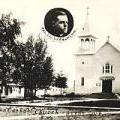 The Crisis in the Seigneuries:
The Crisis in the Seigneuries:
The boom in the Eastern Townships coincided with a severe economic and social crisis in the seigneuries. By the 1820s, there was not enough seigneurial land left to settle French Canada's rapidly growing population. Younger sons and daughters began leaving Quebec by the tens of thousands, mainly for the factory towns of New England. Political and religious leaders grew alarmed. Many of them thought it was a national tragedy that, while their younger generation was leaving, large parts of Quebec, including the Eastern Townships, remained unoccupied. They formed colonization societies to assist settlers and to pressure the government.
Catholic Parishes:
A new law passed by the Legislative Assembly in 1850 allowed the creation of Roman Catholic parishes in the Townships. These parishes would have the right to tax Catholic property and build Catholic schools. This, combined with the new economic opportunities in the region, attracted thousands of French Canadians. The first arrivals found it difficult - they were strangers in a part of Quebec where the language was overwhelmingly English. English was also the language of business and opportunity. In time, however, more French Canadians arrived, enough to build churches and schools.
One of the peculiarities of Eastern Townships toponymy (which is the study of place names) is the result of the "grafting" of a French Catholic parish system to a previously existing English township division or village. Thus it is common to find names like Sainte-Edwidge-de-Clifton, which incorporates the name of a Catholic parish (named after a saint) and that name of the original township. There are countless other examples: Sainte-Catherine-de-Hatley; Saint-Cyrille-de-Wendover; Notre-Dame-de-Lourdes-de-Ham; Saint-Mathieu-de-Dixville; and so on.
Changing Demographics:
By the end of the 19th century, French Canadians would be the majority in most parts of the Eastern Townships. Yet, over a century later, the region is still home to a significant English-speaking population. There are many bilingual and bicultural communities, and the region is frequently cited as a model for harmonious co-existence between the two cultures.